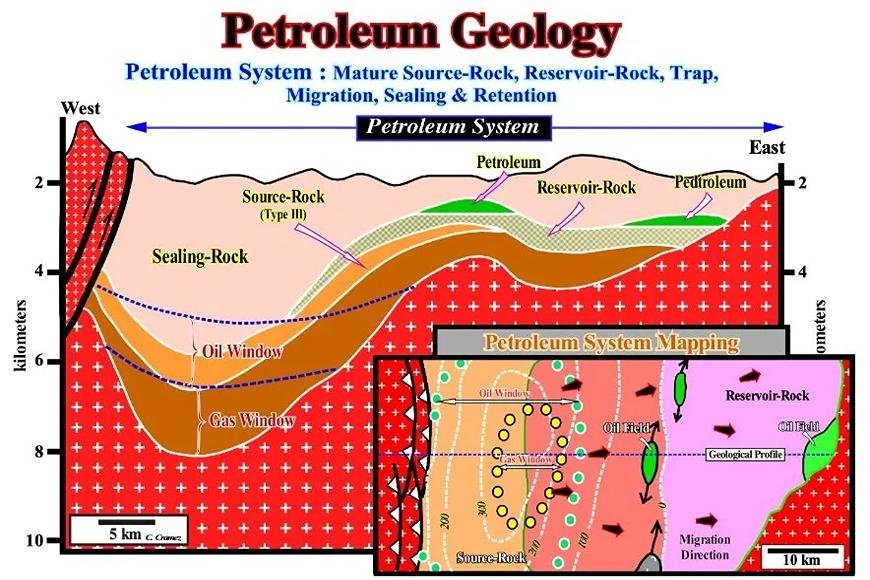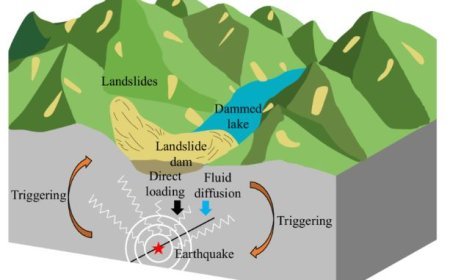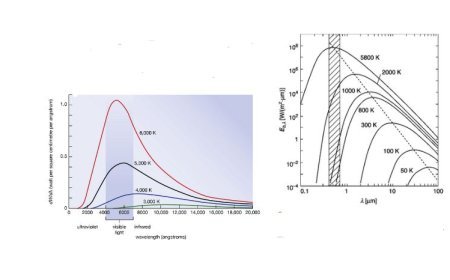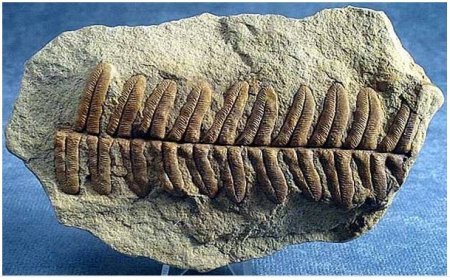PETROLEUM GEOLOGY
Petroleum geology unlocks the secrets of oil and gas formation and hidden reservoirs.

Petroleum Geology
- The study of rock formations and the presence of petroleum inside them is known as petroleum geology.
- It is a critical component of oil and gas reserve exploration, appraisal, and development.
- This area includes knowledge of how petroleum is made, where it can be found, and how it may be removed and produced.
- With rising energy demand and continuous reliance on oil and gas, petroleum geology is becoming increasingly relevant.
- In this essay, we will look at the basics of petroleum geology and its function in the petroleum business.
The origin of petroleum
- The genesis of petroleum is a fascinating issue that has long been the focus of scientific investigation.
- Petroleum is made up of biological stuff that has been exposed to extreme pressure and heat for millions of years.
- The collection of dead plants and animals on the ocean floor begins the process of petroleum production.
- Over time, silt engulfs this organic substance, subjecting it to extreme pressure and heat until it eventually transforms into petroleum.
- The exact situations required for petroleum creation are still unknown, although it is thought that the appropriate mix of temperature, pressure, and the presence of particular microbes is essential.
- The source rock, or the rock formation containing the biological material, must be present as well.
- Shale, limestone, and sandstone are common source rocks.
- Once produced, petroleum migrates from the source rock into neighboring geological formations.
- Petroleum can collect and create a reservoir if certain rock formations are porous and permeable.
- A trap, such as an anticline or fault, must also exist in the reservoir rock to prevent the petroleum from escaping to the surface.
- This trap permits the petroleum to gather and be maintained, allowing it to be extracted.
- In conclusion, the formation of petroleum is a complicated process that includes the buildup of organic material, high pressure and heat, the presence of source and reservoir rocks, and the presence of a trap.
- Petroleum geologists must understand the genesis of petroleum as they explore for new oil and gas sources and try to extract petroleum from current reservoirs.
Petroleum trap mechanism
- Petroleum traps are geological features that keep petroleum from escaping to the surface, allowing it to collect and be stored in a reservoir.
- The trap mechanism is an important component in the creation of a petroleum reservoir and in the exploration and development of oil and gas fields.
There are several types of trap mechanisms, including:
- Structural traps
- Tectonic activity causes the deformation of rock formations, which results in structural traps.
- Common structural traps include anticlines, faults, and dome-like formations.
- Stratigraphic traps
- These traps form when a porous layer of rock is overlain by an impervious layer, preventing petroleum from escaping.
- Pinchouts, shale seals, and mudstones are examples of stratigraphic traps.
- Combined traps
- Some petroleum reservoirs are made up of structural and stratigraphic traps.
- A combination trap, for instance, is an anticline with an impervious layer on top.
- It should be noted that the presence of a trap mechanism does not imply the presence of petroleum.
- A petroleum trap can only form if there is a reservoir rock that holds petroleum.
- Numerous factors, such as the source rock, the reservoir rock's porosity and permeability, and the fluid pressure inside the reservoir, affect the quality and quantity of petroleum in a trap.
- Finally, petroleum traps are an important component of petroleum reservoirs and play an important role in the discovery and development of oil and gas resources. Petroleum geologists must understand the many types of traps and their mechanics as they hunt for new petroleum reserves and strive to recover petroleum from current reservoirs.
Exploration methods
- Petroleum geologists rely on exploration techniques to locate and appraise petroleum reserves.
- Exploration seeks to identify and assess the amount, quality, and recoverability of petroleum reserves.
Petroleum exploration employs a variety of techniques, including:
- Seismic surveys
- Seismic surveys are used to build a subsurface picture of the rocks and fluids under the earth's surface.
- This is accomplished by sending sound waves into the subsurface and monitoring how long it takes the waves to return to the surface.
- Seismic survey data is used to build subsurface maps that can aid in the identification of probable petroleum sources.
- Drilling
- Drilling is the technique of entering the subsurface in order to gather rock samples and fluid data.
- This information is utilized to determine the reservoir's size, quality, and fluid content.
- Exploration wells are drilled to find petroleum, whereas appraisal wells are drilled to establish the quantity and quality of the reservoir.
- Well logging
- The practice of evaluating different physical and chemical parameters of the rocks and fluids within a wellbore is known as well logging.
- This information is utilized to identify the existence of petroleum, the kinds of rock formations, and the reservoir's fluid content.
- Remote sensing
- Remote sensing is the collection of information about the earth's surface using satellite and aircraft photography.
- This information is utilized to identify surface characteristics such as oil leaks and aberrant vegetation that may indicate the presence of petroleum.
- Geological and geochemical analysis
- The examination of rock samples and fluid data to assess the existence and quality of petroleum is known as geological and geochemical analysis.
- This data is used to assess the reservoir's potential and select the best course of action for exploration and development.
- Finally, petroleum geologists rely on exploration techniques to locate and analyze petroleum reserves.
- The combination of these approaches offers a complete image of the subsurface and aids in the identification of the greatest chances for petroleum exploration and production.
- Reservoir rocks are an important component of a petroleum reservoir and are used in the exploration and development of oil and gas resources.
- A reservoir rock is a permeable and porous rock containing petroleum.
- The porosity and permeability of the reservoir rock, the fluid pressure inside the reservoir, and the presence of a trap mechanism that keeps the petroleum from escaping to the surface all influence the quality and amount of petroleum in a reservoir.
- Sandstones, carbonates, and conglomerates are common reservoir rocks.
- Sandstones are constructed of sand-sized mineral grains and are commonly composed of quartz, feldspar, and rock fragments.
- Carbonates are rocks that are mostly composed of calcium carbonate and are frequently created as a result of the buildup of shells and other organic material.
- Conglomerates are rocks made up of big, spherical particles that are frequently created by the aggregation of gravel and boulders.
- A reservoir rock's porosity refers to the amount of vacant space inside the rock and is a significant component in determining the quantity of petroleum that may be stored.
- Large void regions in high-porosity rocks allow for increased petroleum storage. The ease with which fluids may flow through a reservoir rock is referred to as its permeability, and it is also a significant element in determining the quantity of petroleum that can be retrieved.
- High-permeability rocks allow for easy fluid movement and make petroleum extraction simpler.
- Finally, reservoir rocks are critical to the discovery and development of oil and gas resources.
- Petroleum geologists must understand reservoir rock parameters such as porosity and permeability in order to assess the potential of petroleum reservoirs and select the best course of action for exploration and development.
Production geology
- The study of petroleum reservoirs during the production stage is known as production geology.
- The purpose of production geology is to optimize petroleum extraction and maximize oil and gas recovery.
- This includes constant monitoring of the reservoir and wellbore, as well as production process management.
- Production geologists utilize a number of approaches to monitor and optimize the petroleum reservoir.
Among these methods are:
- Reservoir modeling
- Reservoir modeling is the process of developing a numerical model of a petroleum reservoir in order to simulate fluid movement inside the reservoir.
- This assists production geologists in understanding reservoir dynamics and forecasting future output.
- Well logging
- The practice of assessing different physical and chemical features of the rocks and fluids within a wellbore is known as well logging.
- Production geologists utilize this data to monitor reservoir changes and evaluate the success of the production process.
- Reservoir monitoring
- Reservoir monitoring entails continuously measuring fluid pressure, temperature, and other parameters within the reservoir in order to analyze the well's performance and the reservoir's behavior.
- Enhanced oil recovery (EOR) techniques
- EOR techniques are ways of increasing the quantity of petroleum recovered from a reservoir.
- Waterflooding, gas injection, and chemical flooding are examples of such approaches.
- Production optimization
- Production optimization is continuously adjusting the production process to enhance petroleum recovery while minimizing production expenses.
- To summarize, production geology is a critical component of petroleum exploration and production.
- The purpose of production geology is to optimize petroleum extraction and maximize oil and gas recovery.
- To improve the performance of the production process, there is ongoing monitoring of the reservoir and wellbore as well as the use of numerous techniques and technologies.
Enhanced oil recovery techniques
- EOR procedures are ways of increasing the quantity of petroleum that can be recovered from a reservoir.
- The fundamental purpose of EOR approaches is to maximize the economic advantages of oil and gas production by optimizing petroleum recovery.
EOR approaches are classified into various categories, including:
- Waterflooding
- Waterflooding is an EOR process in which water is introduced into the reservoir to displace trapped oil and boost reservoir pressure.
- This increases the flow of oil to the wellbore, making extraction easier.
- Gas injection
- Gas injection is an EOR technique in which gases such as carbon dioxide or natural gas are injected into a reservoir to displace trapped oil and boost reservoir pressure.
- This increases the flow of oil to the wellbore, making extraction easier.
- Chemical flooding
- Chemical flooding is an EOR technique in which chemicals are mixed into the injected fluid to promote oil displacement.
- Surfactants, polymers, and other compounds may be used to change the characteristics of the injected fluid and increase its capacity to displace oil.
4. Thermal recovery
- Thermal recovery is an EOR approach that uses heat to enhance the viscosity of the oil and make it simpler to extract.
- This might involve using steam injection or in-situ combustion.
5. Microbial enhanced oil recovery (MEOR)
- MEOR is an EOR approach in which microorganisms are utilized to boost petroleum recovery.
- This might involve using microbes to degrade oil or generate surfactants to change the characteristics of the oil and make it simpler to remove.
- To summarize, EOR procedures are utilized to improve the amount of petroleum retrieved from a reservoir.
- The purpose of EOR is to maximize the economic advantages of oil and gas production by optimizing petroleum recovery.
- Waterflooding, gas injection, chemical flooding, thermal recovery, and microbial-enhanced oil recovery are all examples of EOR processes.
What's Your Reaction?



































